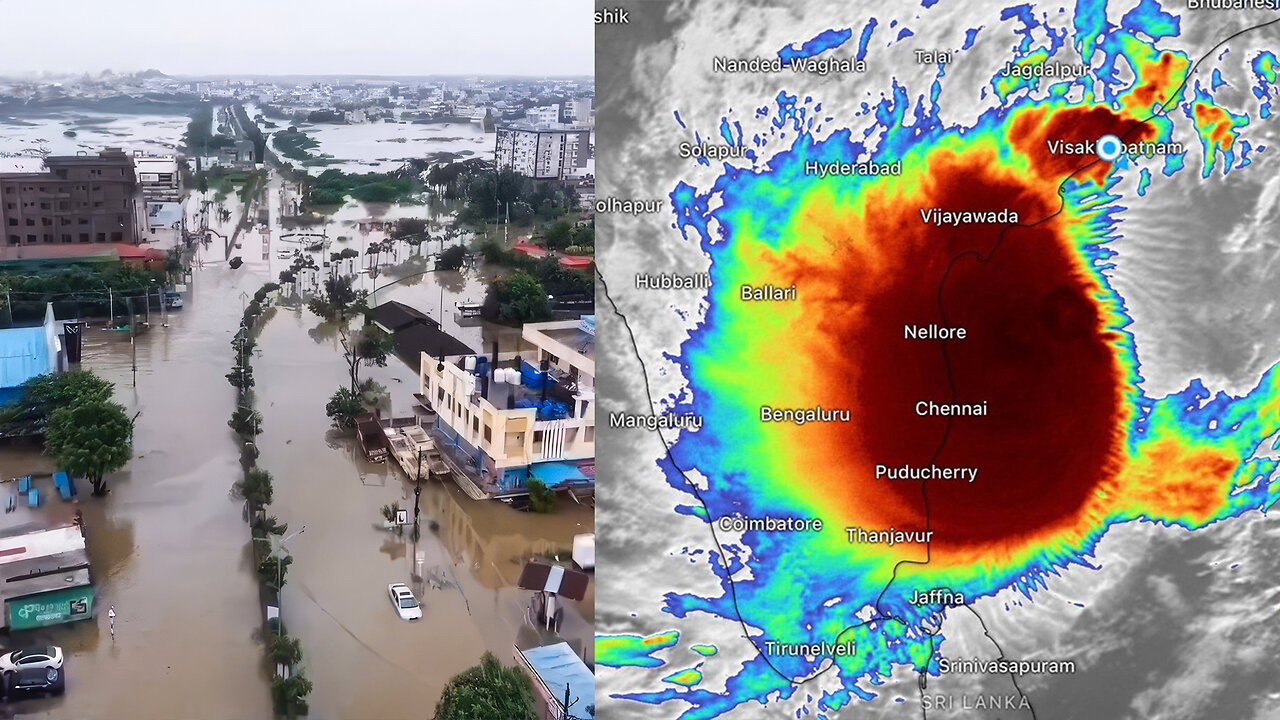Premium Only Content

Cyclone Monta Causes Chaos in India — Massive Floods, Two Million People Affected
On October 28, Tropical Cyclone “Monta”, with wind gusts reaching up to 68 miles per hour and torrential rainfall, struck the eastern coast of India.
The states of Andhra Pradesh, Telangana, and Odisha were the hardest hit. Thanks to the early evacuation of tens of thousands of people from coastal areas, mass casualties were avoided, but the damage was immense.
In Andhra Pradesh, which bore the brunt of the storm, three people lost their lives. The cyclone affected nearly two million residents. More than three thousand miles of roads and over three hundred bridges and culverts were damaged.
Flights were canceled at three international airports in the state, and the South Central Railway suspended operations of at least one hundred twenty trains.
The power grid suffered especially severe damage — strong winds toppled more than three thousand power poles, and over twenty-six thousand transformers were damaged.
In East Godavari District, powerful waves destroyed fishermen’s homes, leaving entire villages homeless.
Authorities set up more than one thousand four hundred temporary shelters, accommodating around one hundred thirty-six thousand people.
About one hundred seventy-four thousand farmers suffered serious losses: fish farms, livestock operations, and poultry farms were flooded. More than two thousand two hundred head of livestock perished. The disaster completely destroyed around ninety-four thousand acres of farmland, and another three hundred forty-one thousand acres of crops — including rice, corn, bananas, cotton, and other produce — were submerged.
In Prakasam District, about two hundred fifty workers were trapped inside tunnels of the Velugonda irrigation project, which channels water from the Krishna River to arid regions. After a canal burst, the tunnels were flooded for nearly six miles, but fortunately, everyone was safely evacuated.
In fifteen districts of Odisha, more than eleven thousand people were evacuated. In Koraput District, over three hundred houses were destroyed. In mountainous areas, landslides and fallen trees blocked roads, cutting off access to remote villages.
The state’s agriculture also suffered significant losses. Cotton and vegetable fields were flooded, threatening to leave thousands of families without harvests or income.
In Telangana, as Cyclone Monta moved inland, it triggered abnormal downpours and flooding. At least six people died in the state. Among them was a woman swept away by floodwaters while trying to cross a submerged bridge despite her husband’s attempts to save her. In Warangal, a bedridden man drowned when water from flooded streets poured into his home.
Floods destroyed roads, damaged power lines, and isolated entire regions.
The Telangana State Groundwater and Disaster Prediction System described the floods as unprecedented. Such statements have become almost routine, as rainfall intensity continues to break records. Yet few specialists are aware — and even fewer have studied — that the intensity of rainfall is directly influenced by micro- and nanoparticles of plastic present in the atmosphere.
You can learn more about how plastic is already affecting natural phenomena and the human body in the detailed interdisciplinary report “Nanoplastics in the Biosphere: From Molecular Impact to Planetary Crisis.”
-
 7:29
7:29
ALLATRA
2 days agoHistoric Early Snowstorm Slams Canada & U.S. — Coldest November in Decades
23 -
 6:10
6:10
Blabbering Collector
12 hours agoSaudi Arabia To Buy Warner Bros, Daniel Radcliffe Comments On HBO Harry Potter
1.73K1 -
 LIVE
LIVE
Lofi Girl
3 years agolofi hip hop radio 📚 - beats to relax/study to
228 watching -
 36:57
36:57
The Pascal Show
1 day ago $0.51 earned'THERE'S NOTHING TO HIDE?!' Trump SUDDENLY Urges House Republicans To Vote Release Epstein Files
1.87K -
 2:50:17
2:50:17
FreshandFit
13 hours agoClavicular Rates The Entire Panel’s Looks & They Get TRIGGERED
291K105 -
 2:22:44
2:22:44
Badlands Media
14 hours agoDevolution Power Hour Ep. 408: Immigration Panic, Epstein Optics & the Narrative Unraveling
100K24 -
 2:06:57
2:06:57
Inverted World Live
8 hours agoBigfoot in Idaho & Insect-Based Bioweapons | Ep. 144
90.3K5 -
 4:02:49
4:02:49
Akademiks
6 hours agoMeg Thee Stallion Back LYING again? Offset vs Finesse2x. 6ix9ine house robbed.. HERES WHO DID IT
40.2K2 -
 2:57:51
2:57:51
TimcastIRL
8 hours agoGOP Rep Threatens Hillary Clinton With CRIMINAL CHARGES Over Epstein | Timcast IRL
263K103 -
 2:36:45
2:36:45
Laura Loomer
7 hours agoEP157: Marjorie TRAITOR Greene Turns On Trump
46.8K104